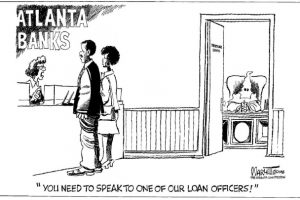For any first time landlords, the thought of finding a tenant can be a daunting task. If you’re as paranoid as I was, all your insecurities and impostor syndromes will surface in full force. What if they don’t like the paint? What if they accuse me of discrimination? What if they are the world’s worst professional tenant and I let a bunch of squatters in?!
Relax. The reality is that the vast majority of renters are kind, courteous, respectful people simply looking for a place to call home. And you have the privilege to offer this amazing person a sanctuary for potentially a very long time. So before we dive into the nuts and and bolts, step zero is to simply embrace a positive mindset on your tenant-landlord relationship. After all, they are your customers.
Step 1: Finding the Perfect Tenant
To find the perfect tenant, it all starts with an assessment of what you’re selling. If your unit is near universities (ex. Allston, Mission Hill, etc.), then you might want to get your listings in front of the student center bulletin boards. Many universities have off-campus housing listing services you can post your apartments on as well. In Massachusetts, I found that Craigslist is still a dominant source for apartment seekers. However, Facebook housing groups are becoming increasingly popular (maybe too popular). There are also paid platforms such as Zillow and Apartments.com which could be a good source. You can also try to ask your friends and family if they know anyone looking for an apartment. Lastly, when you choose to look for a tenant also matters. In Massachusetts, the rental market is highly cyclical with June-September having the highest turnover and December-Feb being the lowest. You know…. Because people don’t like to move when it’s cold and busy stuffing their faces with holiday leftovers.
Finally, before you post, make sure your listing includes the following:
- Amazing Photos – Use a wide-angle lens. Spend the time to clear the clutter and truly stage the place. People will generally ignore your listing if you don’t have photos so you want to get this right.
- Property Description – Be as descriptive as possible. This is your one chance to explain why everyone should rent this unit over someone else’s. Talk about the granite countertop, or proximity to Whole Foods. Talk about the convenience to the MBTA or the Charles River. Whatever makes your property special, try to highlight this.
- Rent Amount – You should do your research and see what’s the top dollar you can get. Use resources like rentometer.com or simply look at other listings in your area to see if you’re too high or too low. One gage for your rental price is the # of applicants you get in the first week of posting. If you find that you’re a picky landlord, then you may want to reduce the price to increase your applicant pool.
- Terms – How long do you expect the lease to be? I generally want 1 year leases but if you want to do short term rentals (STR), then you should make it known here. For most STRs, you will need to provide the place furnished and cover all utilities. This is also why STRs generally command higher prices compared to long term leases.
- Amenities / Utilities Included – Be very clear about utilities are included in the base rent. This may include gas, electricity, water, sewage, etc. If there are other amenities such as shared laundry, you have to make that known.
- Parking – Do you provide parking? Is it tandem parking? Is a parking permit required? Does it require additional parking fees? The goal is to avoid surprises.
- Pets – Pets are a very controversial topic. Some landlords have a blanket no pet policy. Some are more nuanced that allow certain pets. You can also charge pet fees differently. For instance, you can charge a one time pet deposit (that needs to be returned unless pet damages were noted). You can also charge a monthly pet fee (like a pet rent). Or you can just raise the total rent. I’ve discovered the cleanest way to do this is to just raise the total rent.
- Other Rules and Regulations – In the spirit of transparency, you should outline any other funky rules you have about living in the unit. Maybe it’s a vegan commune and everyone is expected to make a meal once a week. Lastly, you’d want to note what payment is required at signing. In Massachusetts you can require the First, Last, and Security Deposit. And maybe a modest application fee. Tenant rights are very robust here so consult an attorney if you’re unsure about if you’re overcharging for move-in fees.
- Contact and Schedule for Showing – Lastly, you should have your email or a de-identified number available for applicants to contact you.
Step 2: Screening for the Perfect Tenant
Finding the right tenant is possibly the most underrated activity in property management. A renter that disregards your rules, doesn’t pay their rent, refuses to leave, and sues you, can leave a trail of serious damages on your property, your financials and ultimately your mental wellbeing. Meanwhile, a good tenant who pays rent on time, notifies you when items are broken, follows your lease, and works with you to resolve problems, is worth their weight in gold.
- Initial Screening – You can learn a lot about a person based on their social media presence and profile. If they post content about damaging their landlords properties, or fighting with her landlords in court, then you might want to steer away. You can also ask some general questions to gage the applicant. Ask about them, their jobs, and living situations. Again, simple questions may reveal a lot about these applicants. If you discover they have a Pitbull and you have a strict no pets policy, then you don’t need to pursue this any further. The trick is to do as much filtering as you can before you have to schedule any in-person meetings.
- Showing – For the applicants that made it through your online screening, you can arrange for an in-person appointment to see the place. With COVID, it’s actually quite popular for folks to virtually tour the unit, and sign a lease site unseen. I don’t recommend this because images can be deceiving and we certainly don’t want the renters to have buyer’s remorse when they move in. At the showing, try to learn as much about the applicant as possible. Ask about their jobs, their hobbies, and try to identify any quirks. Take a peek into their cars and see how that’s organized. An applicant once showed up at my showing in an U-haul truck, fully expecting to move into the unit on the spot! Also pay attention to applicants that like to recite their knowledge of fair housing laws. If they’re bringing up potential legal issues (whether it’s right or wrong), it’s probably not a good sign. Lastly, I would also recommend batching the showings together so you can squeeze as many applicants into the same slot of time. This helps to minimize disruption to the existing residents and the increase traffic will incentivize the other applicants to act quickly!
- Follow Up and Rental Applications – At the end of each showing, make sure to let folks know the next steps. If they are interested, you should have a rental application ready for them to complete. There are a bajillion templates online but I’m happy to share mine if you simply email me at cheng@threadboston.com. Make sure you follow up with all the attendees.
Step 3: Selecting & Onboarding the Perfect Tenant
If you have a desirable property or you have a valid marketing strategy, then you’ll have a long list of applicants to choose from. Make sure to get as many of them to complete the applications as possible, EVEN if you already have folks completing the application or expressed interest in moving in. What matters here is actually getting the lease signed AND having the security deposit paid. Without the signed lease and the deposit in your account, it’s very easy for the applicant to change their minds last minute and kicks you back to square one. So always assume that an applicant may potentially back out until they sign and submitted their deposit.
- Verify Rental Application – The goal of rental verification is 1) make sure that the applicant is indeed who she claims to be and 2) verify if she meets your criteria for a long term responsible tenant. This step would involve calling their current and previous landlords, calling their employers, getting credit reports, and/or CORI checks done. It’s really important to follow fair housing laws here and not discriminate against your applicants based on their race, family status, or other protected statuses. You goal is to get the best tenant for your property and they can come from any walks of life!
- Make the Offer – If you’ve reviewed your applicants and they meet all your criteria, then make sure to reach out immediately and make them an offer to sign the lease. It’s important you don’t wait because good tenants have no issues finding housing!
- Sign Lease and Receive Deposit – Lastly, have a lease ready and ship it out to the applicant for signatures. Make sure to also include instructions on how to get the security deposits to you in the same email chain. Speed is key here and you’d want to get the agreement executed ASAP.
Congratulations if you’ve made it this far! Selecting the right tenant is no small feat and only gets easier/better with time. If you’re interested in learning more about what happens after you’ve selected the perfect tenant, feel free to connect with cheng@threadboston.com and we’re always happy to talk to house hackers in Boston. Good luck!





